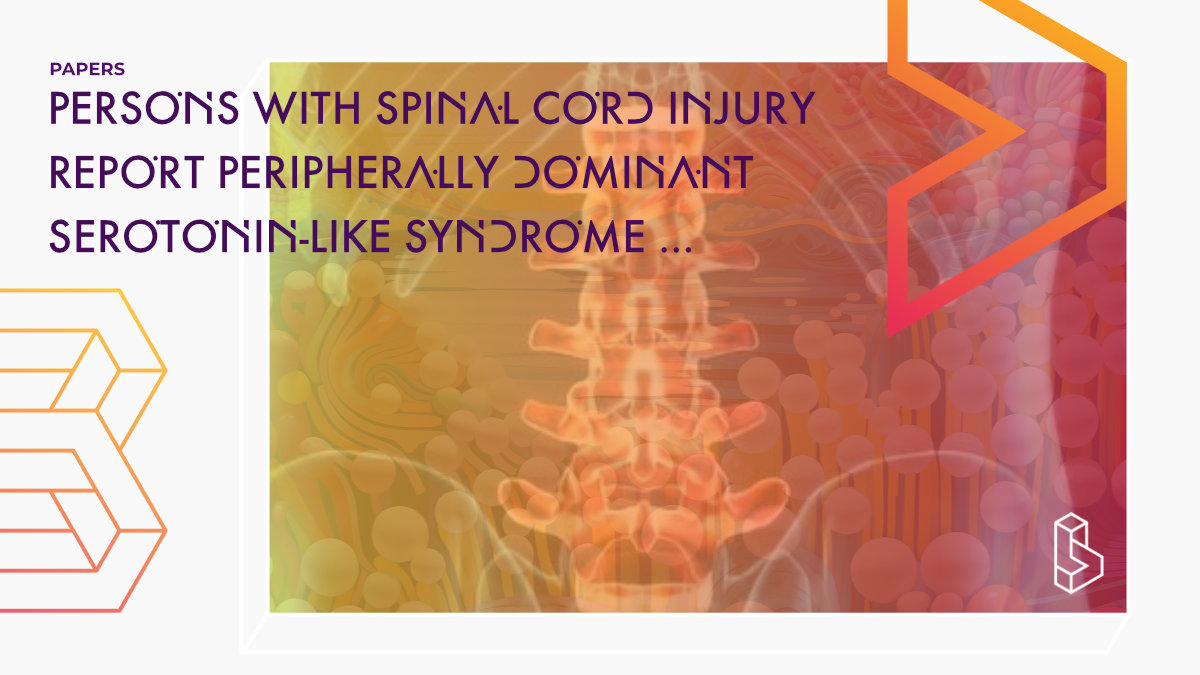This descriptive review (2023) focuses on the reactions of persons with spinal cord injury (SCI) to classical serotonergic psychedelics like psilocybin and LSD. Anecdotal reports from online forums describe neuromuscular and autonomic hypersensitivity, including intense muscle spasms, sweating, and tremors, but with no worsening of baseline neurological deficits. The study proposes this reaction as a peripherally dominant serotonin syndrome-like clinical picture and emphasizes the need for awareness and harm reduction as psychedelic-assisted therapy (PAT) becomes more mainstream.
Abstract of Persons With Spinal Cord Injury Report Peripherally Dominant Serotonin-Like Syndrome After Use of Serotonergic Psychedelics
“Psychedelic-assisted therapy (PAT) may treat various mental health conditions. Despite its promising therapeutic signal across mental health outcomes, less attention is paid on its potential to provide therapeutic benefits across complex medical situations within rehabilitation medicine. Persons with spinal cord injury (SCI) have a high prevalence of treatment-resistant mental health comorbidities that compound the extent of their physical disability. Reports from online discussion forums suggest that those living with SCI are using psychedelics, though the motivation for their use is unknown. These anecdotal reports describe a consistent phenomenon of neuromuscular and autonomic hypersensitivity to classical serotonergic psychedelics, such as psilocybin and lysergic acid diethylamide (LSD). Persons describe intense muscle spasms, sweating, and tremors, with an eventual return to baseline and no reports of worsening of their baseline neurological deficits. The discomfort experienced interferes with the subjective beneficial effects self-reported. This phenomenon has not been described previously in the academic literature. We aim to provide a descriptive review and explanatory theoretical framework hypothesizing this phenomenon as a peripherally dominant serotonin syndrome-like clinical picture—that should be considered as such when persons with SCI are exposed to classical psychedelics. Raising awareness of this syndrome may help our mechanistic understanding of serotonergic psychedelics and stimulate development of treatment protocols permitting persons with SCI to safely tolerate their adverse effects. As PAT transitions from research trials into accepted clinical and decriminalized use, efforts must be made from a harm reduction perspective to understand these adverse events, while also serving as an informed consent process aid if such therapeutic approaches are to be considered for use in persons living with SCI.”
Authors: Stephanie K. Abrams, Brenden S. Rabinovitch, Rayyan Zafar, Aly S. Aziz, Nicholas P. Cherup, David W. McMillan, Jessica L. Nielson & Evan C. Lewis
Summary of Persons With Spinal Cord Injury Report Peripherally Dominant Serotonin-Like Syndrome After Use of Serotonergic Psychedelics
Psychedelic-assisted therapy (PAT) has demonstrated success in treating a variety of mental health conditions, including major depressive disorder (MDD), treatment-resistant depression (TRD), substance use disorder, post-traumatic stress disorder (PTSD), and existential anxiety at end-of-life.
PAT has avoided or actively excluded persons with severe or chronic medical conditions, such as spinal cord injury, or those with specific neurological diagnoses. However, online reporting suggests that self-guided psychedelic exploration occurs in the SCI population, with many describing a problematic set of adverse events.
Intense, nonordinary, and uncomfortable leg spasms are unique to those with spinal cord injury and warrant further investigation.
Find this paper
https://doi.org/10.1089/neur.2023.0022
Open Access | Google Scholar | Backup | 🕊
Cite this paper (APA)
Abrams, S. K., Rabinovitch, B. S., Zafar, R., Aziz, A. S., Cherup, N. P., McMillan, D., ... & Lewis, E. C. (2023). Persons With Spinal Cord Injury Report Peripherally Dominant Serotonin-Like Syndrome After Use of Serotonergic Psychedelics. Neurotrauma Reports, 4(1), 543-550.

